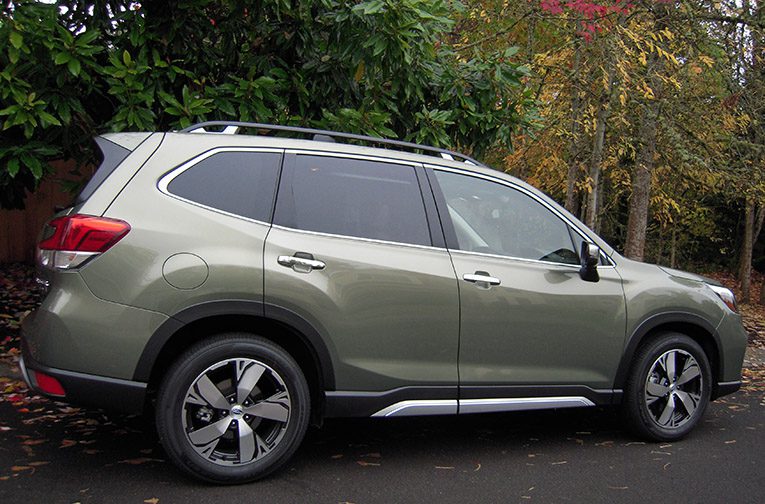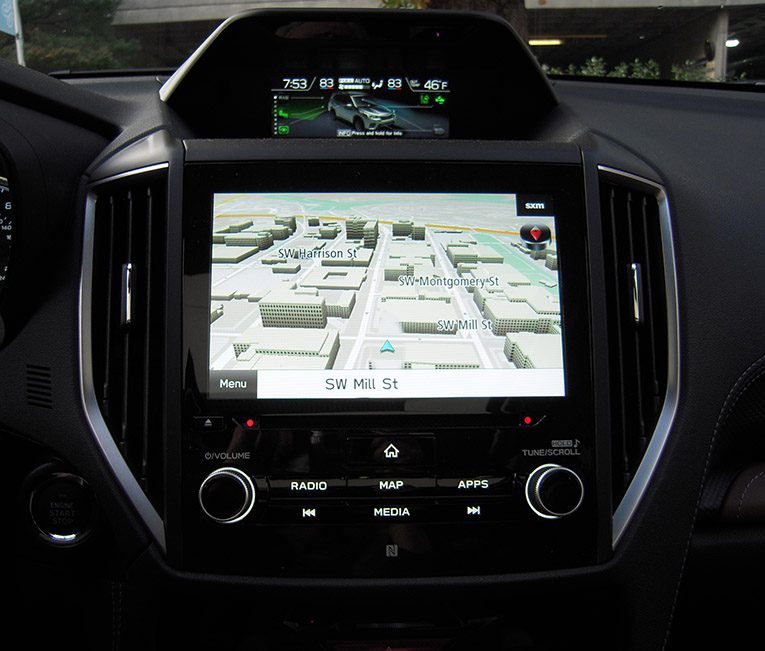The Subaru Forester’s been around since 1997, known as a capable and safe small SUV that you’d feel comfortable putting your kids and dogs in. But it was getting a bit long in the tooth as many rivals offered nicer interiors and more technology. That changes for the 2019 model year as the Forester gets a makeover with an upgraded cabin, more passenger room and several added amenities.
On the outside, the new Forester has some styling cues taken from the Outback. It’s a little less boxy and a bit longer and wider with a larger front grille. It still looks like a Forester, but a more sophisticated one.
The five-passenger Forester is offered in five trims: Forester, Premium, Sport, Limited, and Touring. The Sport trim is new for 2019. All come standard with all-wheel-drive. AWD is available on most rivals but you usually have to pay more for it. Starting prices range from $24,295 to 34,295.
Gone are the old turbocharged engine and manual transmission. There’s just one power train: a 2.5-liter Subaru Boxer four-cylinder engine that makes 182 horsepower and 176 pound-feet of torque, paired with a continuously variable transmission.
The Forester will easily get you from point A to point B with a quiet and smooth ride and enough power for most daily driving situations. But don’t expect zippy performance. You may wish for more oopmh when trying to accelerate quickly or passing at freeway speeds. Buyers who want sportier handling would be better off with the Mazda CX-5 or Ford Escape. The Forester feels more planted when cornering than the outgoing model. Visibility is excellent all the way around. And, of course, Subaru’s AWD system means you’re ready for ever-changing conditions in the Pacific Northwest.
The Forester has 8.7 inches of ground clearance so it can take you off the beaten path if you want some outdoor adventures. When properly equipped the Forester can tow up to 1,500 pounds.
Fuel efficiency is good for a compact SUV, especially with all-wheel-drive. EPA ratings for my tester are 16 mpg city, 25 mpg city and 29 combined. I got 27 mpg during my week with a mix of city and highway driving.
The interior is much nicer than in the old Forester. The cabin has an open and airy feel. Materials have an upscale look and feel and many are soft-touch. The higher trims are downright luxurious with leather seating. Passengers in both rows of seating get more room and will enjoy plenty of legroom in both rows. Two adults or three kids will be comfortable in the second row, although taller passengers may wish for a bit more headroom. The door openings are large and the doors open to an almost 90-degree angle, making it easy to get in and out.
Standard features on all Foresters include a rearview camera, cloth upholstery, automatic climate control, and the Starlink infotainment system with two USB ports, Bluetooth, four-speaker audio system, satellite radio, HD Radio, a 6.5-inch touch screen, and Apple CarPlay and Android Auto.
Subaru’s EyeSight driver assistance technologies are also standard on all Foresters including forward collision warning, automatic emergency braking, lane departure and sway warning, lane keep assist, adaptive cruise control, and lead vehicle take-off alert (when you’re stopped, this alerts the driver that the car in front of you is starting to move.)
Options include proximity keyless entry, push-button start, remote start, sport-styled cloth upholstery, leather seating, leather-wrapped steering wheel, power-adjustable front seats, heated front and rear seats, dual-zone automatic climate control, moonroof, six-speaker audio system, nine-speaker, 576-watt Harman Kardon audio system, two rear USB ports, Wi-Fi hot spot, an eight-inch touchscreen, and navigation system.
The Touring trim gets the segment-exclusive DriverFocus safety technology that uses facial recognition software to identify signs of driver fatigue or driver distraction and provides an audio and visual warning to alert the driver. Subaru says DriverFocus also works with EyeSight to reduce the chance of an accident.The system can recognize up to five different drivers and will automatically adjust seating position and climate controls to each individual’s preferences.
The Starlink infotainment system responds quickly to touch and voice controls, and there are old school buttons and knobs for common functions. Overall, the system is user-friendly although you have to go through some sub-menus to access some functions.
The 2019 Forester has a lot of cargo space for the class. There are 35.4 cubic feet of space behind the second row and 76.1 cubes with the rear seat folded.
The good:
Standard AWD which costs extra on rivals
Good fuel economy especially for AWD
More legroom than previous years
Upgraded cabin with soft-touch materials
User-friendly infotainment system
Android Auto and Apple CarPlay are standard
Subaru’s EyeSight driver assist technology is standard on all trims
Lots of cargo space for the segment
Enough ground clearance for light off-roading
The not-so-good:
Turbocharged engine no longer offered
Meh performance—other small crossovers have peppier handling
Pricing info:
My tester starts at $34,295. Destination fee is $975 bringing the grand total to $35,270.
Bottom line:
Subaru has updated the Forester to provide a nicer cabin, more room, lots of standard technology and safety features, and excellent fuel efficiency. If lively performance is not that important to you, the Forester is sure worth taking for a test drive.












